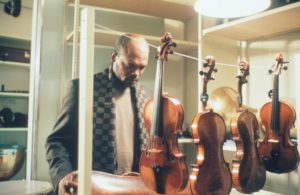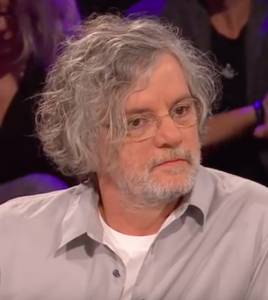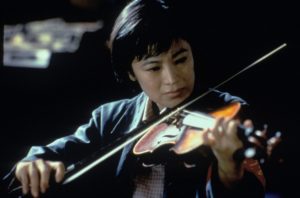Twenty years ago, the film, The Red Violin, soared onto the big screen.
It starred, essentially, a musical instrument, a violin stained red by the blood of a 17th century Italian woman who was the wife of the instrument maker.
There was something enduring about that violin and in the movie it had many lives, in a monastery in Austria, a palatial home in Britain, a store in China during the Cultural Revolution and finally in Montreal where it was going to auction.
The Red Violin was the work of Quebec filmmaker François Girard. It is his best known film and it too has had many different lives. One of them will unfold Tuesday night at the National Arts Centre when the NAC Orchestra and soloist Lara St. John will play the score from the film live as the movie itself is screened. The invite only event for NAC subscribers is one of several such concerts that have been taking place for a few years now.
For Girard, this new “look” and “listen” to The Red Violin breaks with his normal pattern.
“I never look back at my work. I move on. I don’t watch my movies,” he told ARTSFILE in an interview.
“A few years ago when we started working on the concert version, we needed to look back and see. I watched it again. I hadn’t seen it in years. I wouldn’t be able to say this about every film I have done, but this one seems to have aged in a nice way.

Samuel L. Jackson as the appraiser Charles Morritz stares at the red violin which is about to go up for auction.
“Films are like children,” he said. “You put them into the world and they have their own lives. They grow up and become somebody, good or bad or whatever.”
The Red Violin turns out to have had a wonderful life, Girard said.
“And it doesn’t want to die.”
The event at the NAC will bring together Girard, his co-writer Don McKellar and Lara St. John who will perform the violin solos in the performance in Southam Hall. It will be hosted by the federal Heritage minister Pablo Rodriguez.
The concert concept, Girard said, was championed by Schemer, the music publishers of composer John Corigliano, who won an Oscar for his score for The Red Violin.
The first time the live performance concert was done was at the Lanaudiere Festival two and half years ago.
“I was very curious to see it performed like that. I was totally drawn into it. It was wonderful to see an orchestra perform it live and to have a soloist move her bow in sync with the actors on the screen. It added some kind of a 4D dimension to the screening.
“Now it has been done a great number of times around the world. And it has given the film a new career. The event in Ottawa is part of that.”
St. John was the first soloist. And the American virtuoso Joshua Bell, who played the music on the original soundtrack, has also been part of a few of the live performances in the U.S. including a recent event in New York City.

François Girard is seen here in during an interview on Radio Canada.
Girard the filmmaker has been very influenced by music. Consider the fact that the film before The Red Violin was Thirty Two Short Films About Glenn Gould.
“I have always been around music. Even nowadays when I approach a film or a play, it is with musical forms.
“Film and music have a lot in common in the structure of emotions through time and the journeys through experience. Even if you are doing a film that has nothing to do with music you are still influenced by music. Most filmmakers will say the same thing but in my case, my way of approaching narrative work is highly influenced by musical forms and structure.”
Girard is a musical omnivore. He listens to everything and is interested in it all.
He has done an opera before and he has also worked on a film with the rock innovator Peter Gabriel.
“I have worked with experimental music too.” For example, the score for his last film, Hochelaga, was composed by the minimalist father and son duo Terry and Gyan Riley.
Still, 20 years later, asking for an original score for The Red Violin seems particularly inspired.
“The first thing I did for The Red Violin while I was writing the film was to research solo violin repertoire through cadenzas, suites and and concertos; everything written for solo violin.”
So when he came to talking to John Corigliano he was fully prepared.
The idea of performing the film music in concert was there at the very beginning, Girard said.
In fact, “I remember right after editing the film was finished, I flew to San Francisco to hear the first performance of The Red Violin Chaconne.”
Today Corigliano’s orchestral versions of his original score have been played more than 1,000 times around world. The violin concerto from the film has become the most performed modern violin concerto, Girard said.
“To me, it is a great joy to see what we initiated 20 years ago still going.”
Girard thinks that music composed for film doesn’t always get its due.
“There are many wonderful composers dedicated to film work. I think there is a lot happening. You do get the standard usual like anything else but there is so much explorative work being done as well.”
Girard has just finished shooting his next film The Song of Names in Budapest and the composer on that film is the Canadian Howard Shore. (The Song of Names tells the story of two young Jewish boys separated during the Second World War and who are reunited as adults. It stars Clive Owen and Tim Roth. It is co-produced by Robert Lantos)
“(Shore) is a very experienced composer who has worked mostly in film but outside film as well. There are so many crossed paths between the two mediums. We will never be finished talking about it. Film is a great vehicle for music and music is a great vehicle for film.”
The idea of a live performance of The Red Violin has another appeal for Girard.
“We are living in an age when the live theatrical performance is threatened by the home experience. A live performance of Red Violin is completely against the trend. It highlights, in some way, the value of a communal experience of 2000 people sharing an experience at the same moment in the same room.”

Sylvia Chang as Xiang Pei in The Red Violin.
One of the most intriguing scenes of the original movie takes place in China during the Cultural Revolution. Filming that time in the city of Shanghai was one of the most challenging of Girard’s career, he said.
“I remember we filmed exactly at the time of the handover of Hong Kong to China. Shanghai was full of western journalists covering the handover. The authorities felt they had to completely isolate us so about 300 cops closed the neighbourhood where we were filming so no nosy journalist would take photos of our set and publish them as some kind of weird cultural revolution revival.
“They were the most intense shooting days I have ever had in my career. I will remember it on my deathbed.”
Many have said the the star of the film, the red violin, was based on a famous Stradivarius called the Red Mendelssohn. Not so, says Girard.
“A good number of instruments have been called red violins. The varnishes have a tendency to become reddish through oxidation.
“The seed idea of the movie was to use human blood in the composition of the varnish and (inject) some human DNA, soul, essence into the instrument and see that transpire through music.
“We are touching something that is very human. All musical instruments are emulation of the only true instrument which is the human voice. There is something extremely human in the making of such an instrument. This is what the film was tapping into by injecting the human soul into the making of an instrument.”
He said he has been trying to stay away from making another film about music, but “you can’t get away from music.
“The one I am doing now is highly musical also. I take great pleasure in it. I don’t know what it does to a career I’m not thinking that way I am following my art. And music is leading me in many ways.”
He is pleased with The Red Violin, he said.
“I feel it is solid work. As an artist what you aim for is to create a piece that lasts. The Red Violin is probably most resonant and lasting piece of mine.” So far, he added. “Maybe I’ll do better.”
Tuesday’s event has another purpose, Girard says.
“We are also there to convince the community of politicians of the importance of investing in art.” And especially to convince them to increase public funding of Telefilm Canada, whose support was central to the success of The Red Violin and of the Canadian film industry, Girard said.
“We feel Telefilm needs support. The budget has been frozen for too long,” he said. “Without Telefilm, the community of filmmakers would not exist in Canada.”







